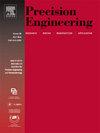Error modeling, parameter identification and non-parametric calibration of a 3PUS/S spherical parallel manipulator
IF 3.7
2区 工程技术
Q2 ENGINEERING, MANUFACTURING
Precision Engineering-Journal of the International Societies for Precision Engineering and Nanotechnology
Pub Date : 2025-05-29
DOI:10.1016/j.precisioneng.2025.05.023
引用次数: 0
Abstract
In comparison to serial manipulators, parallel robots have many applications in industries due to their unique characteristics such as larger stiffness-to-mass and payload-to-weight ratios. Since, the accuracy and error reduction of the manipulators are very prominent, various methods have been proposed to calibrate parallel robots with different structures so far. This article presents the kinematic parameters estimation and non-parametric calibration of a 3PUS/S spherical parallel manipulator. In this regard, the kinematic equations of the manipulator are derived to identify the error sources, then an error model is developed to correlate the errors of the robot's outputs to the inaccuracies of the manipulator's structural parameters and joint variables. In addition, a prototype of the manipulator is designed and made to collect suitable data sets for calibration, then many experiments in the robot's workspace are performed, and the input and output values are recorded by encoder and AHRS sensors with high accuracy. Next, the estimation of geometric parameters is fulfilled by an optimization method, then the artificial neural network is employed for non-parametric calibration. The results show that the geometric calibration based on parameter estimation and non-parametric calibration could improve the robot accuracy about 73 % and 96 %, respectively.
3PUS/S球面并联机械臂误差建模、参数辨识及非参数标定
与串行机械手相比,并联机器人由于其独特的特性,如更大的刚度-质量和有效载荷-重量比,在工业中有许多应用。由于对机械手精度和误差减小的要求非常突出,目前提出了各种方法对不同结构的并联机器人进行标定。介绍了一种3PUS/S球面并联机器人的运动学参数估计和非参数标定。在此基础上,推导了机械手的运动学方程,确定了误差来源,建立了误差模型,将机械手的输出误差与机械手结构参数和关节变量的误差联系起来。此外,设计并制作了机械手样机,采集了合适的数据集进行标定,然后在机器人工作空间内进行了多次实验,并通过编码器和AHRS传感器高精度地记录了输入输出值。其次,通过优化方法实现几何参数的估计,然后利用人工神经网络进行非参数标定。结果表明,基于参数估计的几何定标和基于非参数定标的几何定标分别可使机器人精度提高约73%和96%。
本文章由计算机程序翻译,如有差异,请以英文原文为准。
求助全文
约1分钟内获得全文
求助全文
来源期刊
CiteScore
7.40
自引率
5.60%
发文量
177
审稿时长
46 days
期刊介绍:
Precision Engineering - Journal of the International Societies for Precision Engineering and Nanotechnology is devoted to the multidisciplinary study and practice of high accuracy engineering, metrology, and manufacturing. The journal takes an integrated approach to all subjects related to research, design, manufacture, performance validation, and application of high precision machines, instruments, and components, including fundamental and applied research and development in manufacturing processes, fabrication technology, and advanced measurement science. The scope includes precision-engineered systems and supporting metrology over the full range of length scales, from atom-based nanotechnology and advanced lithographic technology to large-scale systems, including optical and radio telescopes and macrometrology.

 求助内容:
求助内容: 应助结果提醒方式:
应助结果提醒方式:


